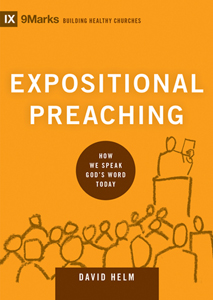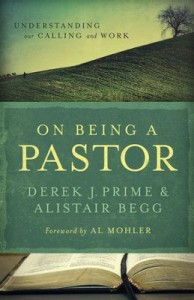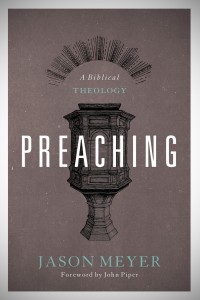People come to me for one thing . . . I preach to them a Calvinist creed and a Puritan morality. That is what they want and that is what they get. If they want anything else they must go elsewhere. – Spurgeon
Category Archives: Preaching
What Is Expositional Preaching?
 David Helm begins his fabulous little book Expositional Preaching with a portrait of the great Charles Simeon.
David Helm begins his fabulous little book Expositional Preaching with a portrait of the great Charles Simeon.
Helm says Simeon’s preaching “had something that much of our preaching lacks.” What might that be? “Simeon believed,” Helm writes, “that a simple and clear explication of the Bible is what makes a church healthy and happy. Biblical exposition does the heavy lifting of building a church.”
Simeon once said,
My endeavor is to bring out of Scripture what is there, and not to thrust in what I think might be there. I have a great jealousy on this head; never to speak more or less than I believe to be the mind of the Spirit in the passage I am expounding.
And this is exactly what is lacking in so much of the popular preaching today. Helm says we need preaching “committed to staying on the line, never rising above the text of Scripture to say more than it said and never falling beneath the text by lessening its force and fullness.”
WHAT EXPOSITION REALLY IS
Many of us experientially know how spot on Helm is. We have sat through preaching that claimed to be expositional, but was far from the true ideal. Sure, the preacher was sequentially walking through a book of the Bible, but lectio continua does not make one an expositor. It is oh so easy to take a text and pull out from it something that isn’t there. Maybe it is the classic “right doctrine from the wrong text,” or it is increasingly likely that a preacher using the text a launching pad for personal musings on just about everything.
One thing that will protect us against unintended imposition on the text is a clear, and right, understanding of what expositional preaching really is. David Helm’s definition is as good as I’ve come across. He says,
Expositional preaching is empowered preaching that rightly submits the shape and emphasis of the sermon to the shape and emphasis of the biblical text.
The strength of his definition, for me at least, is his employment of “shape and emphasis.” If the sermon gets this right then you can bet it brings out of the text what the Holy Spirit put there, not what the preacher thinks is there.
WHAT EXPOSITION SOUNDS LIKE
Paying attention to shape and emphasis bears significantly on structure and delivery. For example, I recently preached a sermon on Mark 14:12-31 where the author employs one of his favorite literary sandwiches. Three sections in the text meant three divisions in the sermon. I could have easily come up with five divisions, but at that point my sermon is not as clearly reflecting the shape of the text. Furthermore, this Markan sandwich exists to emphasize the self-sacrifice of Christ that is announced in the Lord’s Supper. So, my attempt to mirror the text’s emphasis meant devoting most of my explanation and application to 14:22-25.
Now, we ought to mention how much tone comes into play in this understanding of exposition. If comforting promises fill the text, our tone ought to have distinct warmth and sympathy. If threatenings or judgments are emphasized, our voice must have prophetic courage. This kind of attention to emphasis protects the preacher from becoming a one-chord band. Ican point you to many a preacher who are like Creed or Nickleback; no matter the content the song always sounds the same.
STIR ‘EM UP
Decades after his ordination Charles Simeon reflected on his early preaching ministry by saying,
I undertook the care of [of a friend’s church] and I have reason to hope that some good was done there. In the space of a month or six weeks the church became quite crowded; the Lord’s Table was attended by three times the usual number of communicants, and a considerable stir was made among the dry bones. (quoted in Helm, 111).
Work hard this week in your preparation to feed God’s sheep. Labor to rightly submit the shape and emphasis of your sermon to the shape and emphasis of the text. Then go and make a considerable stir among the dry bones.
Colorful Preaching
A few months ago I offered three advantages a manuscript will bring for the ordinary preacher: clarity, sensitivity, and usability.
If one decides preaching from a manuscript is best for his ministry, the decision making is not done. He must then settle on exactly how to format his manuscript: font choice, size, and color being a few things that come to mind.
A DIVERSITY OF EXAMPLES
Several years ago Josh Harris ran a fascinating and edifying series on his blog called, “Preaching Notes (Round 1, Round 2)”. He asked a few well-known preachers to send along whatever resource they took into the pulpit on a recent Sunday: manuscript, outlines, or stick note. Here are a couple examples from men that manuscript their sermons:
- Mark Dever
- David Platt
- Kevin DeYoung
- While I am not sure it is “properly” a manuscript, Tim Keller’s method is nonetheless amazing!
Clearly no two manuscripts are alike and, in many ways, they appear to reflect the preacher’s individual personality. Some have hand-written annotations, while others are more keen on employing font formatting.
A COLOR-CODED SCRIPT
If Josh ever comes along and ask for my manuscript – not in this life! – you’d see a plethora of color. My manuscripts are color-coded, which means:
- Any Scripture quotation is in blue
- Any extra-biblical quotation is in green
- Any illustration, analogy, or metaphor is in red
- Any application is in orange
- The gospel call to unbelievers is in maroon
- Any exposition or explanation is in black
I’ve found color-coding the manuscript to be uniquely helpful in preparation and delivery. When I am preparing a sermon I can generally get a sense of the content’s development by the color. For example, if look at an entire page without any orange (application) or red (illustration, analogy, etc.) it’s likely my exposition of certain points is far too long-winded. Or if I look at a page and see half of it in red, I have fallen off the other side of the horse and the illustrations are taking over. What I am looking for is appropriate balance in color, mostly black and blue, with some subset of color shading each page (my sermons generally run six pages long).
The color-coding is also incredibly useful during sermon delivery. I am a visual learner who functionally memorizes his manuscript. The color helps me quickly situate my mind on any given page of the sermons so that I rarely need to search for particular content. This is particularly useful when I want to read a quote; all I need to do is seen green on the page and start reading. My goal in all this is that my use of a manuscript never becomes obtrusive to my delivery.
Another benefit is that I often do not have to read any specifics of the text the get my homiletical bearings, but only see the color to know what’s coming next. So in the screen-shot above, if I look down when making the point about the Lord’s Supper being an eschatological announcement, I will see a chunk of red and orange coming and thus immediately know the exposition is followed by illustration and application. The color alone is often sufficient to summon the individual parts to memory.
But don’t just take my word for it. If you are a manuscript man feelingly a stuck on black and white, take a dance on the wild side and try color-coding your content. You might be surprised how useful it is.
When the Preacher Hears a Sermon
One of the greatest things a pastor can do is sit under the preaching of God’s word. It’s also one of the hardest.
The difficulty, for many pastors, is their tendency to hear a sermon with critical ears. They are quick to point out where the exegesis was wrong or how the delivery was less than desirable. And many guys I know where this as a badge of ministerial honor. But is it really a good thing? I think not.
What is good is hearing and receiving God’s word with discernment, which is a very different thing than receiving it with criticism. The line between discernment can criticism can be quite fine, but it is nevertheless one on which we would do well to faithfully tread.
I am in the midst of a two week stretch of not preaching at IDC and am thus learning this lesson once again. I recently listened to a Q&A session at Westminster Theological Seminary with John Piper where he was asked to speak to this very issue. His answer is characteristically wise and helpful.
Any preacher would do well to listen to this challenging and edifying five minute clip.
The Peril of Despair
 I have written before (here, here, and here) about the great weight I often feel after preaching. That descent from the sacred desk is a walk normally filled with steps of despair and discouragement.
I have written before (here, here, and here) about the great weight I often feel after preaching. That descent from the sacred desk is a walk normally filled with steps of despair and discouragement.
I am always helped to know I am not alone in the struggle. Such encouragement came earlier this week from On Being a Pastorby Derek Prime and Alistair Begg. Their chapter on preaching ends with a section on “The Perils of Preaching,” which mentions the peril of “despair and sense of failure.”
The following back and forth between Prime and Begg was valuable for me to hear, as I bet it would be for any preacher.
Derek Prime: “I doubt if there has been a Sunday I have preached when I have not had some [despair or sense of failure]. On occasions I have known deep despair because I have felt I have been so clumsy in my presentation of the truth. At such times we need to remind ourselves of God’s call. I have come to recognize that God allows such things to happen so that I cultivate the humility that befits a teacher of His word and to teach me my constant dependence on Him. One of the most humbling experiences I know is to discover afterward that on the occasions when I felt I did badly, God has been pleased to work in a special way in people’s lives!”
Alistair Begg: “I am encouraged to know that Derek feels this way. I had hoped that this sense would pass with time. But it hasn’t. As I stood to preach this past Sunday, I felt as though I was standing in a telephone box, and, although I could see the people outside and could hear my own voice (usually a bad sign), I had no assurance that they could hear me. Eric Alexander told a gathering of ministers that when he left the pulpit and returned to his vestry, he found himself saying out loud, ‘Lord, I am sorry.’ Lloyd-Jones was as outspoken on this matter as any I have read. ‘Any man who has had some glimpse of what it is to preach will inevitably feel that he has never preached. But he will go on trying, hoping that by the grace of God one day he may truly preach.'”
So preacher, if you often sense despair take comfort from these brothers, and by God’s grace, go on preaching!
“The more thoroughly your mind is steeped in the Spirit of prayer, and of communion with God, when ascend the sacred desk, the more easy and delightful will it be to preach; the more rich and spiritual will your preaching be; the more fervent and natural your eloquence; and the greater the probability that what you say will be made a blessing.” – Samuel Miller
One Meal at a Time
One of my best friends growing up had a Chihuahua named Goliath. The name was rather apt, for Goliath was the largest little dog I’ve ever seen.
His girth was due, it seemed, to the chaos often surrounding meal time at my friend’s house. They were a large family with large appetites and small worries about any food falling to the floor. And so it was that Goliath’s girth expanded.
If dogs could talk I doubt Goliath would recall many specifics about the offerings he consumed, yet his weight would bear great testimony to their power.
And so it is with faithful preaching.
THE RIGHT PERCENTAGE
I doubt my preaching experience and evolution is terribly different from many pastors. My first three years were spent in student ministry, and weekly preaching to teenagers allowed me to figure out the preparation and delivery methods best suited to my personality. The next five were spent as an associate pastor with sporadic preaching opportunities (6-8 times a year). And these years were spent in regular pursuit of “the home run.”
But it didn’t take long to realize that home runs in the pulpit were elusive, and few and far between. On-base percentage was, and is, better than slugging percentage. Faithful exposition, week in and week out, is the ordinary means by which God grows His church.
PREACHING THAT FATTENS THE SOUL
I have come to think of the preaching as being somewhat like those mealtimes at my friend’s house from days gone by, when Goliath excitedly snapped up any and every crumb. Many of my church members will not be able to recall specific sermon points or applications years after the original delivery. But, Lord willing, what you will be able to see is the quantitative impact of their soul feasting on God’s word. You’d see souls transformed for the glory of God and being powerfully renewed unto the image of Christ. Their spiritual weight would bear testimony to the power of God’s word.
And that really is to be the preacher’s aim isn’t it? Souls fattened by the truth and in the truth. Paul said, “Him we proclaim, warning everyone and teaching everyone in all wisdom, that we may present everyone mature in Christ.”
Now, that is a good word . . . mature.
We preach to present men, women, and children mature before God. So rather than aim for the rightly desired, but rarely achieved grand slam of exposition that blows the winds of revival through the city, let’s aim for the simple and plain preaching of God’s word.
Such preaching fattens the soul.
Teaching & Preaching
 Yesterday I prepared the first draft of my sermon for this Saturday on Mark 13 and kept thinking to myself how the text demands an unusual amount of what I would call “teaching.”
Yesterday I prepared the first draft of my sermon for this Saturday on Mark 13 and kept thinking to myself how the text demands an unusual amount of what I would call “teaching.”
I thought to myself, “Is that a good thing? Shouldn’t I have more ‘preaching’ in the sermon?” Then I remembered Jason Meyer’s helpful discussion on the relationship between teaching and preaching in his excellent book Preaching: A Biblical Theology.
TEACHING VS. PREACHING?
He says that preaching has three phases: stewarding, heralding, and encountering. The stewarding phase focuses on the content of preaching, the heralding phase focuses on the tone of preaching, and the encountering phase focuses on the reception of preaching.
He believes, and rightly so in my view, that the two terms stewarding and heralding help us understand the relationship between teaching and preaching. “I believe preaching refers to how something is stated (in a heraldic way), while teaching focuses on the content of what is said (unpacking something)” (24). He goes on to say,
Another reason why people should not sharply distinguish preaching and teaching is that the two are often used interchangeably in Scripture. For example, the response to Jesus’ most famous sermon (the Sermon on the Mount) defines the sermon as ‘teaching’ (Matt. 7:28). In the same way, a verse in Romans sheds light on the interchangeable nature of the terms. Paul lays down a general statement for the Jews: ‘You then who teach others, do you not teach yourselves?’ (Rom. 2:21). When he give an example of this principle, he uses the term ‘preach’: ‘While you preach against stealing, do you steal?’ (2:21).
Therefore, the combination of the terms stewarding and heralding honors the intricate connection in Scripture between preaching and teaching. (24)
In short, preaching has to do with tone and teaching with content.
The best sermons preach and teach. They provide an education in Christ leading the soul to exultation of Christ. The next time you ascend to the sacred desk be both a steward and a herald.
Teach in your preaching and preach in your teaching.
Have Bibline Blood in Preaching
Last week at T4G I was struck afresh by the powerful preaching of men – like Piper, Platt, and Duncan – who use illustration and analogy quite sparingly. From whence does their power come?
The word of God.
They know that illustrations are vital homiletical tools, but stories and analogies cannot animate a soul dead in sin or heart assaulted by Satan’s wiles. Only the word of God can give life. Therefore, in addition to faithful and clear exposition, we ought to recover the beauty of a sermon whose entire content has the melody of Scripture.
Samuel Miller, that old trainer of preachers at Princeton, knew how powerful preaching can be when it is gloriously brimming with biblical language. He said, “Let everyone who wishes to excel in Sermonizing, take the utmost paints to have his mind deeply imbued with the spirit and language of the Word of God.” Telling his students that true eloquence is spiritual in nature, Miller goes on to say,
Whether, then, you wish to form the best pulpit style, to attain the highest spirit of real eloquence, or most effectually to awaken, instruct and impress those who hear you – let your Sermons – and, in order to this, let your minds be deeply imbued, thoroughly pervaded and filled with the spirit and language of the Bible.
PRICK YOUR PREACHING
We want to be like John Bunyan, of whom Spurgeon said, “’Why, this man is a living Bible!’ Prick him anywhere—his blood is Bibline, the very essence of the Bible flows from him. He cannot speak without quoting a text, for his very soul is full of the Word of God. I commend his example to you, beloved.”
How might we strive after an imbuing of Bible that makes ones blood bibline?
4 PURSUITS FOR BIBLINE BLOOD
Read the Bible. As much as we’d wish this could be a “given,” it sadly isn’t. With Lloyd-Jones, we say that every preacher ought to read the entire Bible at least once a year. “But isn’t that legalistic?” you ask. Banish away such a silly notion and dark scheme! If you are a preacher you are a Bible-man first and foremost. Master this text before you master the Puritans, Calvin, or any other towering giant in Christian history. A Bible reading plan like M’Cheyne’s will be a faithful friend in this pursuit.
Memorize the Bible. Be like the blessed man in Psalm 1 who meditates on the Word day and night. Memorizing verses here and there is good, but memorizing books of the Bible is better. It helps protect against proof-texting that ignores context. It will fill you soul with life-giving words. I’d recommend memorizing an epistle and then memorize some choice Psalms. Andy Davis’ little booklet on Scripture memorization is most useful.
Pray the Bible. Not only is praying Scripture a great way to infuse life into your secret prayer, it’s also a powerful way to let the word get dug down deep. The Psalms and prayers of Paul are great places to start.
Talk about the Bible. I do believe the preparation for preaching is a unique vehicle to fill the mind with Bible, but I am thinking about more casual conversation here. Read a book of the Bible with young men in your church, talk about it with your kids, and converse about it at every opportunity. You’ll find the soul soaking up truth at every turn.
How can a pastor preach intelligently and appropriately to his people, without knowing their state? . . . O! that ministers could be persuaded to realize that the best part of their preparation for the pulpit, that which is best adapted to impart the richest instructiveness, and the most touching unction to all its teaching, is, not to seclude themselves perpetually in their studies – not to be forever trimming the midnight lamp; but to got forth and put themselves often in contact with the cavils and objections of the enemies of the gospel, as well as with the anxieties, the conflicts, the consolations, the joys, and the triumphs of Christian believers. – Samuel Miller





